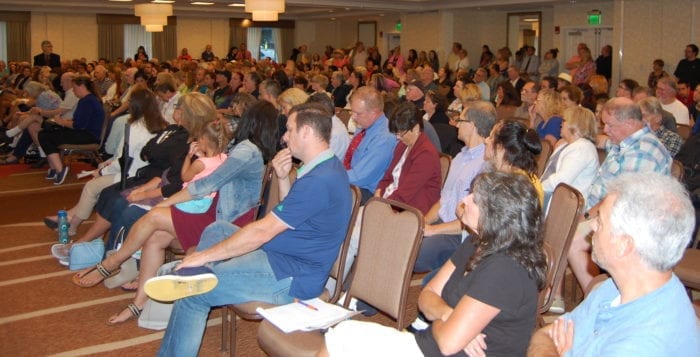By Anthony Frasca
Brad Hutton, the deputy commissioner of the New York State Office of Public Health, delivered sobering news to a standing-room-only crowd at the Hilton Garden Inn Stony Brook July 17.
At a public hearing, Hutton told concerned residents that the New York State Cancer Registry had identified three local communities with significantly elevated cancer rates for four common cancers. The affected communities include Centereach, Farmingville and Selden.
“Two of my son’s friends have cancer. One has acute lymphoblastic leukemia and one has a sarcoma.”
— Cindy Faicco
The four cancer types that were discovered to be well above the state average include lung, bladder, thyroid and leukemia. The cancer registry statistics disclosed that the rates of these cancers above the state averages were: thyroid, 43 percent; bladder, 50 percent; lung, 56 percent; and leukemia, 64 percent.
Concerned Centereach residents Cindy and Dennis Faicco had questions about how the state would handle such a discovery.
“I want to know how much they are going to reveal,” Dennis Faicco said. “I’m curious if this is just the tip of the iceberg.”
“Two of my son’s friends have cancer,” Cindy Faicco said. “One has acute lymphoblastic leukemia and one has a sarcoma.” She also said that there were other children in the area who had developed cancers.
The cancer registry has had gold-level certification since 1998, according to Hutton. New York State laws mandate cancer reporting, and this contributes to the accumulation of data; and with statistical analysis, it allows the state to identify areas of concern throughout the state.
Currently there are four areas throughout New York State that are being investigated for cancer clusters. Staten Island is being investigated because it has the highest incidence of cancer rates of the five New York City boroughs. East Buffalo and western Cheektowaga in Erie County are being studied for a high incidence of six forms of cancer, and Warren County has the highest incidence rate for all forms of cancer.
In addition to educating the audience about various causes and types of cancer, Hutton outlined a detailed plan for the upcoming state investigation.
“Simply living in a highlighted area does not mean a person is more likely to get cancer,” Hutton said, referencing a map of the three Long Island communities.
“Simply living in a highlighted area does not mean a person is more likely to get cancer.”
— Brad Hutton
The timetable for the upcoming investigation included identifying study areas, releasing cancer mapping, getting input from community members and finalizing study questions. Hutton outlined a one-year timetable to complete the investigations and recommendations, and results will be shared with the community at another public hearing by the end of 2018.
A number of residents shared personal stories of cancer and expressed concern about numerous potential sources of contamination, especially drinking water. Hutton assured the audience that the Office of Public Health would be responsive to the community’s input and would explore the issue in depth. He said that the community input would be helpful in focusing the state investigation.
Contaminated drinking water, radiation from towers, nitrates, emerging chemicals and pesticides, radium, high-tension wires and industrialization of the entire island were all highlighted issues identified by audience members in a question and answer session.
“We can’t be drinking radium,” one resident said. “That’s an emergency as far as I’m concerned.”
Ken from Centereach was concerned about high-tension utility wires and petroleum pipes feeding holding tanks. He said he had been diagnosed with a rare intestinal cancer and that his 32-year-old daughter developed a rare sarcoma.
“Here we sit with a zebra and a unicorn-type cancer,” he said. “Do you look at those in your studies?”
Joseph from Babylon told of developing a rare bladder cancer and implicated overchlorination of the water supply in addition to overindustrialization.
“As far as I’m concerned this island is done,” he said. “I can’t wait to move off this island. There is something very horribly wrong here. You can stop everything you’re doing right now, and this island will be done for a hundred years.”
The Faiccos were curious why there was little mention of childhood cancers, yet they were hopeful.
“He didn’t have any answers but we’re going to come back and hope he has some in December,” Cindy Faicco said.





